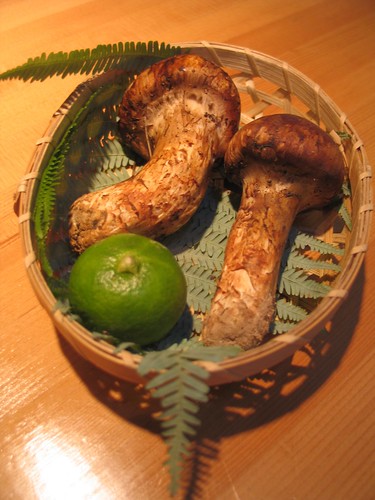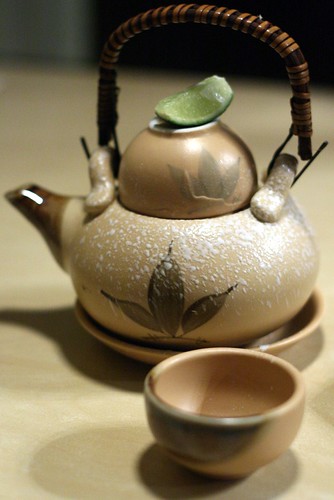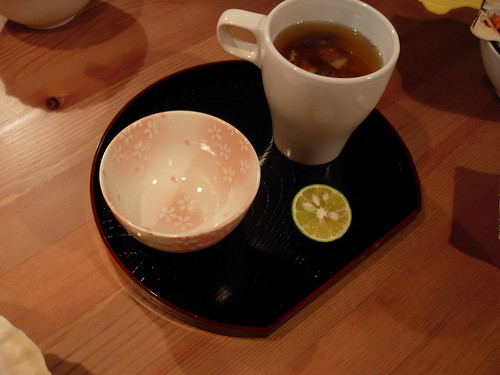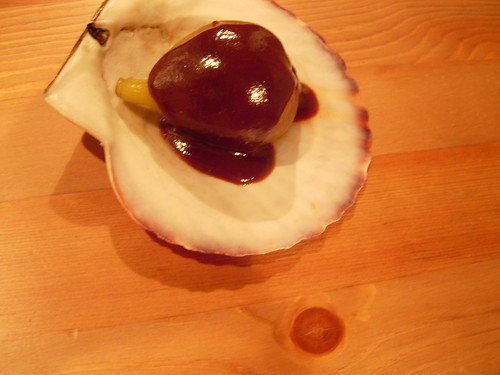Inspired by this post at KyotoFoodie, I decided to try matsutake mushrooms in season. The season is short, the mushrooms are much loved across Japan, and I thought I’d better try them now before I lose my chance.
Matsutake are also very, very expensive. I searched up and down at Nishiki market for what I wanted: two good mushrooms. They normally come packaged at least four or five at a time, which is too many to use all at once first time out. I was a little startled: I knew they could be expensive, but this is outrageous! Here, dead center, you can see a box (the one with a very fat mushroom, just above the blank space) marked at 15 man, which is to say 150,000¥, or $1,500.
Okay, given what's going on in the world economy, what kind of maniac shells out $1500 for a box of mushrooms? Fortunately, you don't have to get that crazy, and I had no intention of doing so. At the same time, I didn’t want el-cheapo ones: if you’re going to have them, you want them to be decent enough that you get the flavor. In the end, I settled on a cute little box of two for a little under $30 total. Here they are:
Now what you make with these things, mostly, is either matsutake gohan (matsutake rice) or matsutake dobin mushi (matsutake steamed in a teapot). But if you’re only serving two plus a toddler, two mushrooms is a lot for either of these. So I decided to make both: neither is at all difficult, technically.
But that might get repetitive, so I decided to get interesting. From a blog entry I spotted about somebody’s dinner at a Kyoto kaiseki place, I worked out how to make a fig dengaku, which is fig with a sweet miso sauce.
Not difficult, actually, and apart from the screaming baby and mildly misbehaving toddler, it was an extremely nice meal. I don’t think I’m going to drop thirty bucks on matsutake any time soon (to say nothing of thousands!), but other than that these were very repeatable dishes, worth working on.
Matsutake Dobin Mushi
What you’re supposed to do is put chunks of matsutake into little individual teapots along with some protein (usually chicken thigh, shrimp, duck, or hamo eel) and a sake-flavored dashi stock. Then you steam the teapots for ten minutes or so. To serve, you give each person his own teapot, and put a little cup on top with a half sudachi lime. People pour the soup in the cup, squeeze sudachi on, and drink the soup and eat the chunks out of the pot.
I decided it wasn’t worth buying these little pots for a one-time thing. If we decided we adored the dish, we’d want decent pots, but it’d be crazy to buy these if we decided it was just sort of okay. So I steamed the stuff in tall teacups covered with plastic wrap, which works fine but doesn’t look as nice.
For protein, I used hamo (pike conger eel), which is sort of ubiquitous in Kyoto from late summer into autumn. You buy this pre-prepared: to make it yourself, you need a special knife and a hell of a lot of skill, and you end up with a huge amount of eel that doesn’t keep especially well, and what’s more the prepared stuff isn’t expensive.
To make 3 medium-small servings, you need 3 cups of dashi, 1 Tb soy sauce, 2 Tb mirin (sweet rice wine), 1 Tb salt, 1 matsutake mushroom, and 6 chunks of your protein, plus 3 sudachi halves (fat lime or yuzu wedges would work fine too). Combine the dashi, soy, mirin, and salt, and bring to a strong simmer. Brush (don’t wash) the matsutake and cut in half crosswise, then tear it into fat shreds with your fingers (it divides easily). Divide the mushroom pieces and meat evenly into 3 big teacups or medium coffee mugs. Prepare a steamer: I put a steamer rack in the bottom of a big pot and added water to come just a little below the rack, then bring it to a boil over high heat. Divide the hot soup across the mugs, then seal tight with plastic wrap. Carefully place them in the steamer and put on the lid. Steam over medium-high heat for ten minutes or so. Turn off heat, open the lid away from you to dissipate the steam, and very carefully remove the cups. To serve, peel off the plastic at the table (the steam smells wonderful), and have people eat the soup and the chunks with a squeeze or so of the sour citrus to taste.
I found that this dish tastes quite nice but overrated. I was expecting a powerful fragrance reminiscent of earth, as with morels or truffles. Instead, matsutake are woodsy and surprisingly subtle. I suppose you could say that a morel is to a truffle as a shiitake is to a matsutake. I generally prefer dried shiitake to fresh, because the latter strike me as having more texture than flavor, and the drying process intensifies the flavor effectively without unduly damaging the texture. So maybe it’s just that matsutake aren’t my thing?
I’d love to try this dish with fresh morels: the blast of earthy fragrance would be heavenly, I expect. Obviously it’d work well with truffles too. I do think you’d want something a little more forceful than dashi to stand up to that kind of intense flavor; dilute veal stock seems about right.
Matsutake Gohan
Now this is brainless cooking: a very good dish with no work at all. Again, I’d love to try it with earthier mushrooms.
What you do is, you take 3 big servings of dry rice and wash well in cold water. Then you put the strained rice in the rice cooker and add the right amount of water according to the cooker. Let sit 30 minutes. Then add 2 Tb sake and 2 Tb soy. Sprinkle on 1 matsutake mushroom prepared exactly the same way as in the previous recipe, and about half a pad of deep-fried tofu cut in thin slices. Close the cooker and run it the normal way. When it’s done, gently toss the rice with the paddle to mix evenly.
I preferred this to the dobin mushi, but again, I think this isn’t my mushroom. With morels, or truffles of course, it would be absolutely spectacular. You’d want spring vegetables instead, like super-fresh peas off the vine, or maybe smallish chunks of asparagus, depending on what’s available. I think I’d use white wine instead of sake and reduce the soy by half; I might add a teaspoon of excellent balsamic vinegar instead or in addition.
So the matsutake part was very good, but a little disappointing.
Fig Dengaku
Dengaku is usually a chunk of tofu or eggplant that’s broiled with a sweet miso glaze. This is such a good dish, and so popular, that it’s evolved a wide range of variations. This one I saw in a blog somewhere as something eaten at a fancy kaiseki place in Kyoto, but I had no recipe. So I made it up.
You need: 3 very ripe figs, 1 cup water, 1 Tb soy sauce, 3 Tb mirin sweet cooking sake, 3+ Tb sugar, 2 generous Tb dark miso. Mix the water, soy, 2 Tb mirin, and 1 Tb sugar in a small saucepan that will fit the figs comfortably but snugly in one layer. Wash the figs gently and add to the saucepan. Let marinate for several hours or overnight, turning occasionally. Mix the remaining sugar and the miso in a smallish bowl, stirring constantly until fairly smooth. Add the remaining mirin and stir until smooth. Bring the saucepan to a strong simmer, reduce heat to very low, and cover the figs with a circle of parchment sitting directly on top; this will help them braise rather than steam. Continue simmering gently for 15 minutes or more, until the figs are quite soft but not breaking. Very, very gently remove the figs to individual serving plates (I used the other halves of the scallop shells). Add a spoonful of the hot braising liquid to the miso mix and stir until dissolved. Continue adding the braising liquid, a little at a time, until the mixture is hot, the sugar is dissolved, and the sauce is the texture of melted chocolate. Spoon sauce over the figs and serve immediately.
I was very proud of this dish. One minor annoyance was that the scallop shells weren’t a great idea: they tip, and the figs have a lot of liquid, so serve in a proper little bowl. My only real complaint was that the fig skins were much firmer than I had expected. Next time I make it, I will blanch the figs first quickly and peel them, and I’ll serve with little spoons as well as chopsticks (western silverware would be better!). All in all, I’m proud of the fact that I started with a photo and a 10-word description from a non-expert blogger, and in one smooth shift executed a very successful dish. I’d do this again — in fact, I will do this again, and soon.
So...
A successful dinner, and I thought a passable test of the whole matsutake issue for us. Conclusion: they’re fine, but I don’t get the hullabaloo. And with the world economy doing what it’s doing, those prices are ludicrous!




No comments:
Post a Comment